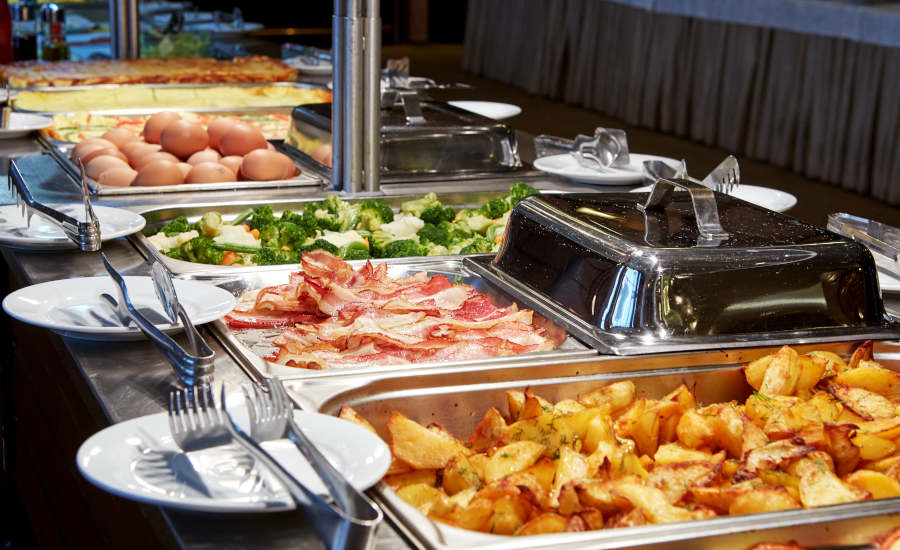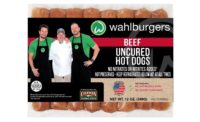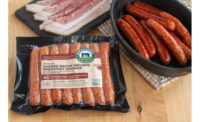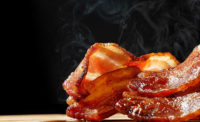This year has seen a tremendous resurgence of breakfast meats due to the effects of the COVID-19 pandemic combined with improved quality, convenient formulations and consumers’ demands for high protein at breakfast.
“Bacon and sausage and all the handhelds are doing extremely well,” says Chris DuBois, Chicago-based IRI’s senior vice president. “It’s really they are right in the middle of all those trends sitting there, and it’s a great year to be in the breakfast meats business.”
This year, breakfast meats including bacon and sausage are well into double-digit growth, DuBois says. Even in the 12 weeks ending Aug. 30 IRI reports volume is up 16 percent and dollar sales are up 18 percent.
Driving that growth are people working and learning from home.
“When people have more time for breakfast in the morning, it changes decisions,” DuBois explains. “… No longer is it just something convenient going out the door, but it’s bacon and sausage.”
Combine that with the fact that restaurants have been challenged during the pandemic. Breakfast occasions at restaurants are down because many people don’t commute anymore and many drive-through lanes are cumbersome.
People also continue to seek protein at the store. IRI has seen protein over index consistently across categories.
Bacon of all varieties has had a fantastic year with the resurgence of breakfast at home. All pack sizes also are resonating with consumers with even bulk sizes being extremely successful as consumers look to save money. Private-label bacon also is doing well, as it’s being upgraded in several markets in which retailers are actively changing their products to be more in line with national brands, DuBois says. Bacon is approximately a $6.2 billion category in the United States with most brands experiencing growth well into the double digits, IRI reports.
Breakfast sausage is about 40 percent of bacon sales and reached about $2.5 billion this year, IRI says. While bacon is overwhelmingly a raw category, about one-third of breakfast sausage product is fully cooked, which provides consumers portability.
Keeping breakfast fresh
Innovation in cooked bacon, with product coming over to retail from foodservice that are either partially cooked or fully cooked, tend to be of much better quality than they were five years ago, DuBois says. This has contributed to cooked bacon’s tremendous growth.
Additionally, processors continue to innovate around making breakfast more convenient and mobile, particularly combinations of meat and eggs, with enormous innovation in cups and frozen products that are handheld. This is a continuation of a trend that began before the COVID-19 pandemic, but consumers still want convenient products in different forms combined with high protein even during these months of pandemic modifications, DuBois says.
Consumers also are experiencing cooking fatigue and need new inspiration and ideas for preparing simple meals at home, says Mel Coleman, Jr., vice president of Coleman Natural Foods, in Westminster, Colo. Coleman has been producing new recipes that incorporate bacon to inspire families to go beyond the traditional means of using various products.
“It is important that brand packaging clearly communicates key attributes as well as sharing recipes and preparation tips and tricks,” Coleman says.
Consumers are demanding food that is both quick to prepare and home-cooked, says Lu Ann Williams, global insights director at Innova Market Insights, in Arnhem, The Netherlands. The macronutrients protein, sugar and fiber are three of the top four influencers of food and drink choices, she adds.
Innovation in breakfast meat and poultry products is moving to foods that traditionally were not convenient to prepare, especially for one person. Instead, manufacturers are innovating with fast, easy-to-prepare microwaveable cups, Williams says. New product development in the last year has included handheld breakfast solutions such as Jimmy Dean Casserole Bites, Biscuit Roll-Ups and Morning Combos.
She expects more high-protein, lower-carb breakfast solutions, especially with post-pandemic weight-loss goals. Additionally, she expects more focus on reducing added sugar and artificial sweeteners.
“The popularity of cups and bowls offer an opportunity in breakfast innovation focused on creating solutions that meet intensifying consumer demand for quick, healthy and individualized solutions is growing,” Williams says. “These products also are positioned as tasting fresher, being more like a homemade egg, meat, potato and veggie scramble.”
Moving forward, Innova expects to see more claims around sustainability and regenerative farming, and meat companies should look for opportunities to highlight the efforts they are making, Williams says.
“Budgets are being tightened and shoppers today want to make sure when they do spend money, they are buying quality food they feel good about feeding their family,” Coleman says. “Consumers are more interested in where their food is coming from and will be looking for meat products raised in the U.S.A. on farms that care about the humane treatment of their animals.”
Chicago-based Mintel International research also has found that Millennials are significantly more interested in international influences for breakfast and brunch foods compared with older generations. Furthermore, this group is much more interested in non-traditional breakfast/brunch foods such as burgers and pizza for breakfast.
Mintel research also found that 40 percent of all consumers say they eat breakfast foods at other mealtimes. For Millennials and Generation Z, that behavior is even more pronounced: 46 percent of those ages 18-34 eat breakfast foods at other mealtimes.
“We are certainly seeing the encroachment of non-traditional breakfast foods into the morning mealtime, but that is absolutely a two-way street, especially for younger generations for whom breakfast foods are suitable for almost any daypart and vice versa,” says Billy Roberts, Mintel’s senior analyst in food and drink.
“At-home breakfast sales should continue to grow, albeit not necessarily solely for the morning,” he says. “Whether additional lockdowns occur or not, people appear to be adapting to working from home and, for that matter, embracing it. This should open the door for retail breakfast brands to establish themselves as convenient and trusted options whether that is for the morning meal or another daypart.”
Additionally, people generally consider breakfast foods to be nutritious and healthy, and for a consumer base for whom health is at the forefront in the wake, or midst, of a pandemic, they could well gravitate toward breakfast foods for that reason alone.
“Such options that promise to offer an additional healthy benefit, be it fiber or protein content or even the promise of a cleaner or more-natural formulation, should strongly resonate with people,” Roberts says.
As far as looking forward into next year for breakfast meats, IRI’s DuBois expects it to be another positive year with a strong supply coming from farmers. That means plenty of breakfast meat, and the cost should be attractive. IRI also sees demand staying strong as people have become used to cooking breakfast at home.
“At the very least, we are going to see some of those some of those temporary shifts become permanent,” DuBois says.
IRI also reports the breakfast meats category’s internet sales are growing twice as fast as other food categories, posting between 80 and 120 percent increases depending on the month.
“This is forcing a huge change for manufacturers and retailers as well, especially in the bacon and sausage worlds, which are very brand focused,” DuBois says. “The ability to get that into a shopper’s basket, and get it into the purchase history so it comes up for repurchase, is a really big deal.” NP
Restaurants fight for breakfast

At restaurants, the breakfast daypart is facing challenges because of the pandemic and breakfast wars that already were heating up before the pandemic.
Operators are taking various approaches to driving traffic in the morning daypart, including promotions, new menu items and expanded takeout or delivery service, says Anne Mills, senior manager of consumer insights at Chicago-based Technomic, a Winsight Co.
“We’re seeing some menu innovation, in part to provide new options to help drive traffic, but also to provide options that will be well-suited for takeout and delivery,” Mills says.
Several industry-wide trends such as plant-based or meatless menu offerings and new or global flavors are expected to continue to grow. For example, faux meat proteins and other alternative protein sources are taking the place of bacon, sausage and egg on breakfast menus, especially for new breakfast sandwiches.
“This could eat into the share of meat and poultry items, particularly pork, at breakfast,” Mills says.
Moving forward, the breakfast daypart will continue to face challenges because of the pandemic and breakfast wars will intensify, creating a need for more differentiation.
“This could come in the form of menu innovation and/or new off-premise services and amenities that enhance convenience at breakfast,” Mills says. “Shifts to smaller off-premise focused locations points to a potential need for menu options that are simple and require less equipment to execute.”
While delivery makes up a small share of breakfast orders, it was already on the rise before the pandemic and growth will accelerate as a result. “This points to a need for more breakfast options that hold up during transit for takeout and delivery, such as breakfast sandwiches or bowls,” Mills says.





Report Abusive Comment